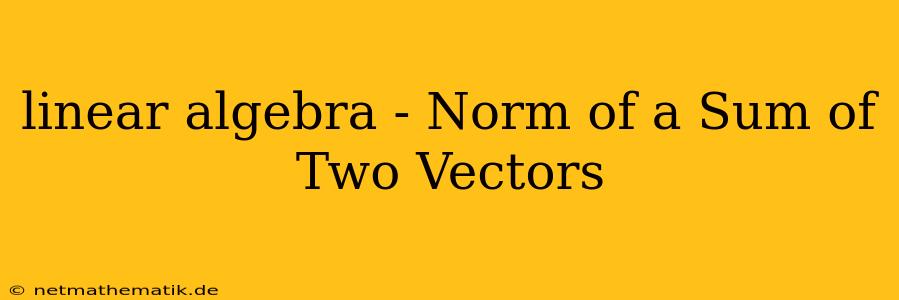Linear algebra is a fundamental branch of mathematics that deals with vectors, matrices, and systems of linear equations. One of the key concepts in linear algebra is the norm of a vector, which measures its length or magnitude. Understanding the norm of a vector is essential for various applications, including optimization, machine learning, and computer graphics. In this article, we will delve into the concept of the norm of a sum of two vectors and explore its properties and applications.
Understanding the Norm of a Vector
The norm of a vector is a non-negative real number that represents its length. It is denoted by double bars around the vector, such as ||v||. The most common types of norms are:
- Euclidean norm (L2 norm): This is the standard norm that we are most familiar with. It is defined as the square root of the sum of the squares of the vector's components. For a vector v = (v1, v2, ..., vn), the Euclidean norm is calculated as:
||v||2 = √(v1² + v2² + ... + vn²)
- Manhattan norm (L1 norm): This norm is defined as the sum of the absolute values of the vector's components. For the same vector v, the Manhattan norm is:
||v||1 = |v1| + |v2| + ... + |vn|
- Maximum norm (L∞ norm): This norm is defined as the maximum absolute value of the vector's components. For vector v, the maximum norm is:
||v||∞ = max(|v1|, |v2|, ..., |vn|)
Norm of a Sum of Two Vectors
The norm of a sum of two vectors is an important concept in linear algebra. It is a measure of the length of the resultant vector obtained by adding two vectors. The general principle is that the norm of the sum of two vectors is less than or equal to the sum of the norms of the individual vectors. This property is known as the triangle inequality.
Triangle Inequality
For any two vectors u and v in a vector space, the following inequality holds:
||u + v|| ≤ ||u|| + ||v||
This inequality states that the length of the sum of two vectors is less than or equal to the sum of their lengths. Geometrically, this can be visualized as the sum of two sides of a triangle being greater than or equal to the third side.
Proof of the Triangle Inequality
The triangle inequality can be proven using the following steps:
- Square both sides of the inequality:
(||u + v||)² ≤ (||u|| + ||v||)²
- Expand the squares:
||u + v||² = (u + v) • (u + v) = ||u||² + 2(u • v) + ||v||² (||u|| + ||v||)² = ||u||² + 2||u|| ||v|| + ||v||²
- Use the Cauchy-Schwarz inequality:
(u • v) ≤ ||u|| ||v||
- Substitute the inequality into the expanded expressions:
||u||² + 2(u • v) + ||v||² ≤ ||u||² + 2||u|| ||v|| + ||v||²
- Simplify the inequality:
2(u • v) ≤ 2||u|| ||v||
- Divide both sides by 2:
(u • v) ≤ ||u|| ||v||
This result confirms the Cauchy-Schwarz inequality, which is essential for proving the triangle inequality.
Applications of the Norm of a Sum of Two Vectors
The norm of a sum of two vectors has various applications in different fields, including:
-
Optimization: The triangle inequality is fundamental in optimization problems, particularly in convex optimization. It allows us to bound the norm of a sum of vectors, which helps in finding optimal solutions.
-
Machine learning: In machine learning, the norm of a sum of vectors is used in various algorithms, including support vector machines (SVMs) and neural networks. It helps in measuring the distance between data points and finding optimal decision boundaries.
-
Computer graphics: The norm of a sum of vectors is crucial in computer graphics for calculating distances, transforming objects, and rendering scenes. It allows us to manipulate objects and create realistic visual effects.
-
Signal processing: In signal processing, the norm of a sum of vectors is used for analyzing and processing signals. It helps in filtering noise, detecting patterns, and compressing data.
Conclusion
The norm of a sum of two vectors is a fundamental concept in linear algebra with significant applications in various fields. The triangle inequality provides a crucial bound for the norm of the sum, allowing us to understand and manipulate vectors effectively. By understanding the norm of a sum of two vectors, we can gain deeper insights into the properties and applications of linear algebra in different domains.
